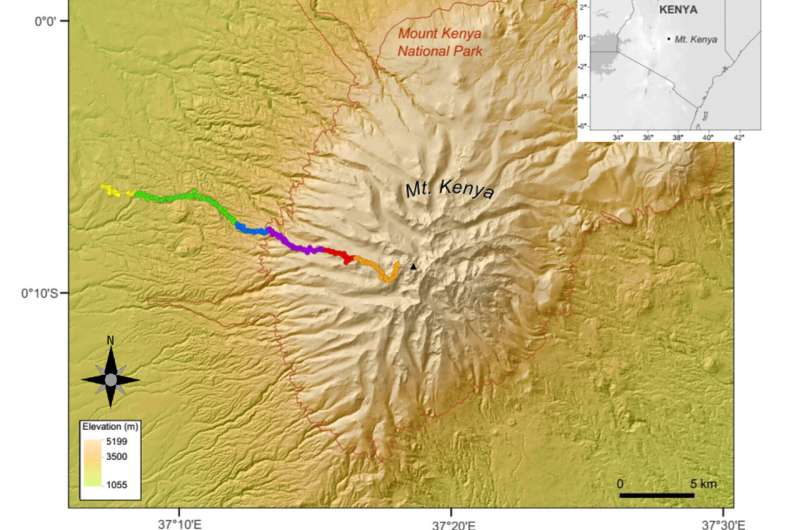This article has been reviewed according to Science X's editorial process and policies. Editors have highlighted the following attributes while ensuring the content's credibility:
fact-checked
peer-reviewed publication
trusted source
proofread
Mammals on 'sky islands' may be threatened by climate change, human development

A new study sheds light on how climate change and human development threaten mammal species living in isolated biodiversity hotspots known as "sky islands."
Researchers placed camera traps throughout Mt. Kenya National Park in East Africa, following the same route up the mountain used by Theodore Roosevelt during his expedition there in 1909.
The paper, "Shifting mammal communities and declining species richness along an elevational gradient on Mt Kenya," is published in the journal Ecology and Evolution.
By comparing their new photos to those taken during the Roosevelt expedition, the researchers were able to observe how mammal communities had changed over six different habitat types located within a relatively small geographic area. This mosaic of habitats hosted a wide range of species, but many of those species were only found in one or two different habitats.
"These highly specialized species are threatened by a phenomenon known as the 'elevator to extinction,'" said Matt Snider, corresponding author of the study and a Ph.D. student at North Carolina State University.
"Certain species are adapted for specific temperature or habitat conditions, but the risk of climate change is that those habitats are increasingly moving up the mountain," Snider said. "The animals that normally live at those higher points are then pushed even further up the mountain. As you get closer to the top, these animals run out of places to go."
This problem is compounded by the isolated nature of mountainous places like Mt. Kenya, which earns them the nickname sky islands. Sky island is a term ecologists use for species-rich, high-elevation areas that were largely colonized by animals following the last glacial period.
As those climate conditions receded, they left behind animal populations that specialized in these habitat conditions and could not survive away from their mountains, leaving them stranded amid the vast savannahs and agricultural land of East Africa.
At higher elevations, large mammal diversity had decreased significantly since the Roosevelt expedition. Above 4,000 meters, common elands were the only large herbivores that the researchers recorded. This left them as the only remaining members of a high mountain community that as recently as 50 years ago included African elephant, plains zebra, hartebeest and African buffalo.
While elephants and buffalo were still present at lower elevations, the camera traps did not capture plains zebra or hartebeest at all. Black rhino, African lion, African wild dogs and mountain bongo, all historical residents of Mt. Kenya, were also completely absent despite researchers setting up cameras in ideal habitat for all four species.
While the study raises serious concerns about the health of sky island ecosystems, the researchers also made some exciting discoveries. Camera traps observed the rare Jackson's mongoose three times, a surviving population not scientifically documented on the mountain in more than a century. The researchers also observed honey badger and aardvark, two species never before seen on Mt. Kenya.
The study demonstrates the need for a holistic approach to protecting sky island habitats, Snider said.
"Each of these different habitats is unique, and we can't just focus on protecting one type of space. We need to be able to protect the whole gradient of different habitats, because each of them has a mammal community that cannot be replicated elsewhere," he said.
"When it comes to things like climate change, we need to develop a broad, systematic understanding of how to deal with that. If we don't, we could potentially lose these very unique mammal communities on the mountain."
More information: Matthew H. Snider et al, Shifting mammal communities and declining species richness along an elevational gradient on Mount Kenya, Ecology and Evolution (2024). DOI: 10.1002/ece3.11151
Journal information: Ecology and Evolution
Provided by North Carolina State University




















